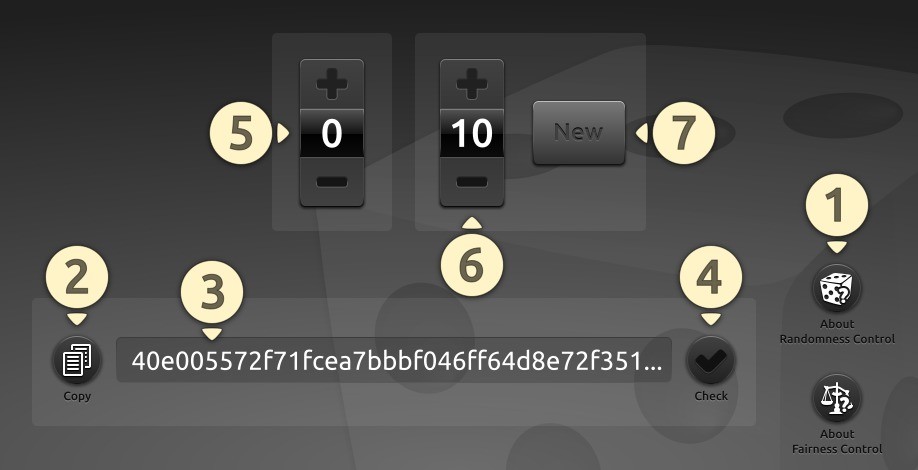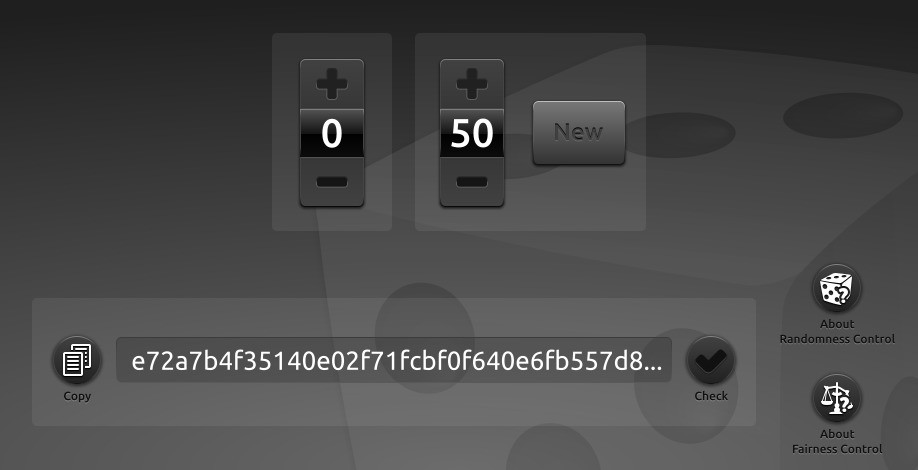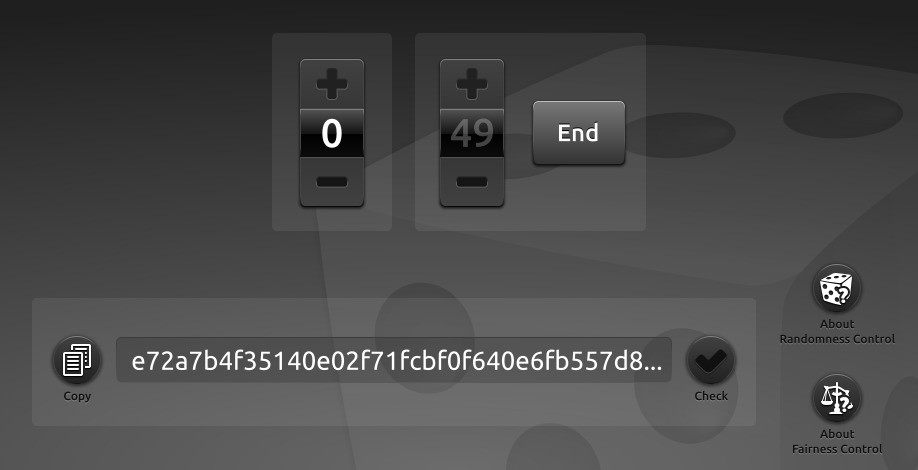Randomness Control for Roulette and Wheel of Fortune
- Randomness Control on Roulette with One Zero (European)
- Distinctive Features of Randomness Control on American Roulette
- Distinctive Features of Randomness Control on Multiball Roulette and Roulette Express
- Distinctive Features of Randomness Control on No Zero Roulette
- Distinctive Features of Randomness Control on No Zero Multiball Roulette and No Zero Roulette Express
- Distinctive Features of Randomness Control on Wheel of Fortune
Randomness Control on Roulette with One Zero (European)
A game with randomness control is conducted during a series of successive spins, and the length of a series can be determined by the player himself. The random sequence of numbers is formed before the beginning of a series. These numbers range from 0 to 36 and correspond to those numbers, on which the ball is supposed to land. The player can change the ‘planned’ number before each regular spin by defining so-called corrective shift.
When the game session starts, the first random sequence of numbers is created automatically. By default, this sequence consists of 10 numbers, so the length of the appropriate series of spins is equal to 10. A game with randomness control is conducted with the help of the panel that is located in the bottom part of the game window. Just click on Randomness control to get this panel:

The 1 button is used to receive reference information. In field 3, the player can see the checksum of sequence, computed according to the SHA-256 algorithm. Using the 2 button, this checksum can be copied to the clipboard. In field 6, the length of the series of spins is shown. If the player wants, he can indicate a different length in this field. The length must be in the range from 1 to 60. When the player indicates the new length, the 7 button becomes active:

In order to create a random sequence of numbers with the new length, the player must press this button. The checksum of this sequence will appear in field 3, while the 7 button will no longer be active:

After each spin in the series, the number in field 6 decreases by 1. In such a way, the number of spins remaining in the series is displayed in this field. At that moment, the 7 button becomes active again, but its status changes from New to End:

If the player wants, he can press this button to abort the current series of spins before all the spins have been used. He can do it at any point in the series.
Before each regular spin, the player can change the number in the sequence that must fall out in roulette. For this purpose, the player uses field 5 to define a shift—a number ranging from 0 to 36. The shift is used for the correction of the ‘planned’ number. Namely, the number, which will fall out in roulette in the present spin (0–36), is calculated in the following way: the shift is added to the number from a random sequence. If this sum is higher than 36, then 37 is subtracted from the sum.
Example. The random sequence of numbers is: 10, 15, 20, 36, 25. The shifts defined by the player are as follows: 25, 30, 18, 36, 12. The wheel will stop at the sectors with the following numbers: 35, 8, 1, 35, 0.
When the series of spins is completed (or if the series has been aborted by the player), the next random sequence of numbers is created automatically. The length of this series will be equal to the previous one. As before, the player can determine the new length of the series and continue the game using the appropriate random sequence. At that moment, the player can use the 4 button to check the results of the just finished series. A new window opens where the player can see information about the entire sequence of numbers formed earlier. He can now confirm that, with regard to shifts, it strictly corresponds to those numbers that fell out in roulette (this means that the player must remember or write down these numbers). The information about the sequence appears as a text line, for example:
After the word spins, the player can find the numbers that were supposed to fall out in roulette (without considering corrective shifts). After the words server code word, there is a random key phrase that is formed by the server for casino safety.
By clicking on the Calculate checksum button, the player will see the checksum for the text information mentioned above. The player can then compare this checksum to the one received at the beginning of the game, when the random sequence of numbers was formed. The fact that these two sums correspond proves that the game used the same numbers that were created at the start.
If the player chooses, he can view information about all sequences of numbers that were created during the current game session. He can scroll through them using the previous and next buttons.
When the player wants to finish the game and presses the Exit button, the game session will be closed, and if his sequence of numbers was not finished, all the data will be lost. If the player wants to continue the game with that particular sequence, he should postpone the session using the standard way of closing the window (with the close button in the upper-right corner). When he renews the session, he can resume the game with the previous sequence.
Distinctive Features of Randomness Control on American Roulette
Double zero (00) is equal to 37. Numbers from random sequence, formed in advance, range from 0 to 37. The shift, chosen by the player to correct the ‘planned’ number, is within the same range. The calculation of the number that falls out in the given spin (0–37), is conducted in the following way: the shift is added to the number from a random sequence. If this sum is more than 37, then 38 is subtracted from the sum.
Example. The random sequence of numbers is: 10, 15, 20, 00(37), 25. The shifts defined by the player are as follows: 25, 30, 18, 2, 12. The following numbers will fall out on the roulette: 35, 7, 0, 1, 00(37).
Distinctive Features of Randomness Control on Multiball Roulette and Roulette Express
These games are based on European roulette, but three different numbers can fall out in each spin. Therefore, there is not one but three numbers per one spin in a random sequence that is formed before the beginning of a series. All numbers range from 0 to 36. When the player checks the results of the finished series, the information about the sequence appears as a text line. Consider an example for the series of ten spins:
The numbers of spins are indicated here (from 1 to 10) and, after each spin’s number, there are three different numbers that were supposed to fall out in this spin (without considering corrective shift). As usual, the text line ends with a random key phrase that is needed for casino safety.
Please note that the actual amount of balls that a player chooses in Multiball roulette is unknown at the moment the sequence is formed. Hence, the text line is always created allowing for the maximum amount of balls - 3.
Before each regular spin, the player can define the corrective shift — a number ranging from 0 to 36. This shift is just one; it’s a community shift for all three numbers used in a random sequence. Appliance of community shift is necessary: according to the game rules, all balls must land in different sectors on the roulette wheel.
Let us return to the example above. It is assumed that numbers 3, 15 and 28 will fall out in the first spin. However, assume that the player defined shift of 10. In this situation, other numbers would appear on the roulette — 13, 25 and 1. These numbers are calculated in the same way as in European roulette. After every spin, the corrective shift can be changed. For example, a shift equal to 20 could be entered before the second spin. Numbers 7, 25 and 0 will appear on the roulette instead of ‘planned’ numbers 24, 5 and 17.
Distinctive Features of Randomness Control on No Zero Roulette
The zero has been removed from the European roulette wheel. Numbers from random sequence, formed in advance, range from 1 to 36. The shift, chosen by the player to correct the “planned” number, can vary from 0 to 35. The calculation of the number that falls out in the given spin (1-36), is conducted in the following way: the shift is added to the number from a random sequence. If this sum is more than 36, then 36 is subtracted from the sum.
Example. The random sequence of numbers is: 10, 15, 20, 36, 25. The shifts defined by the player are as follows: 25, 30, 18, 35, 12. The following numbers will fall out on the roulette: 35, 9, 2, 35, 1.
Distinctive Features of Randomness Control in No Zero Multiball Roulette and No Zero Roulette Express
Randomness control in these games is very similar to the one used in Multiball roulette and Roulette Express. But these games are based on No Zero roulette rather than European roulette. Therefore, all numbers from the random sequence formed in advance range from 1 to 36 (rather than from 0 to 36). The corrective shifts, chosen by the player, can vary from 0 to 35. The numbers that appear while accounting for the player's shifts are calculated in the same way as in No Zero roulette.
Example. Three "planned" numbers in the regular spin are as follows: 26, 27, 36. The player defines the shift of 10. The following numbers will fall out on the roulette wheel: 36, 1, 10.
Distinctive Features of Randomness Control on Wheel of Fortune
The Wheel of Fortune has 49 sectors, each ordered from 1 to 49. For players’ convenience, the numbers that correspond to the sectors, are inscribed on the inner part of the wheel.
Numbers from random sequence, formed in advance, range from 1 to 49 and correspond to the sectors upon which the wheel is supposed to stop. The shift, chosen by the player to correct the "planned" number, can vary from 0 to 48. The number upon which the wheel will stop in the present spin (1-49), is calculated in the following way: the shift is added to the number from a random sequence. If this sum is higher than 49, then 49 is subtracted from the sum.
Example. The random sequence of numbers is: 10, 15, 20, 36, 26. The shifts defined by the player are as follows: 25, 30, 38, 36, 24. The wheel will stop at the sectors with the following numbers: 35, 45, 9, 23, 1.































